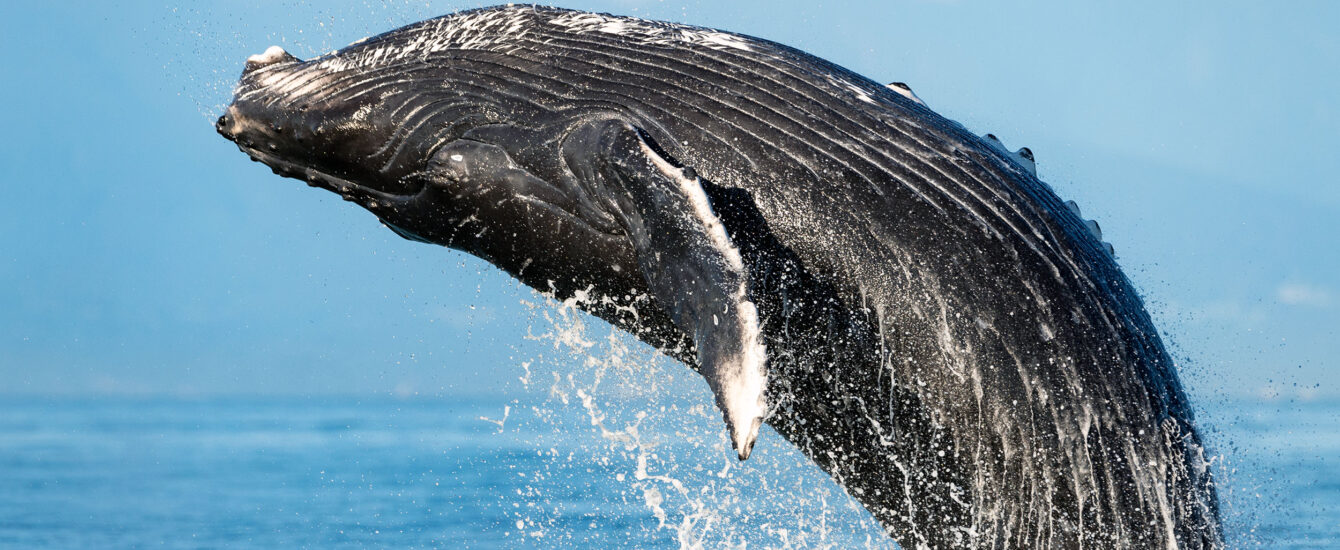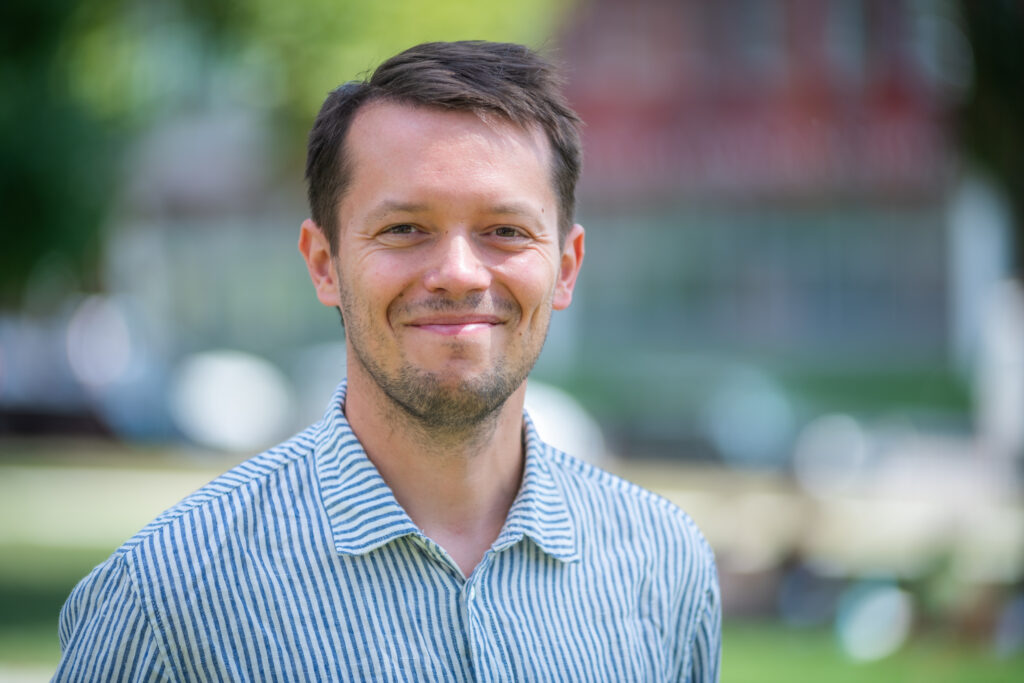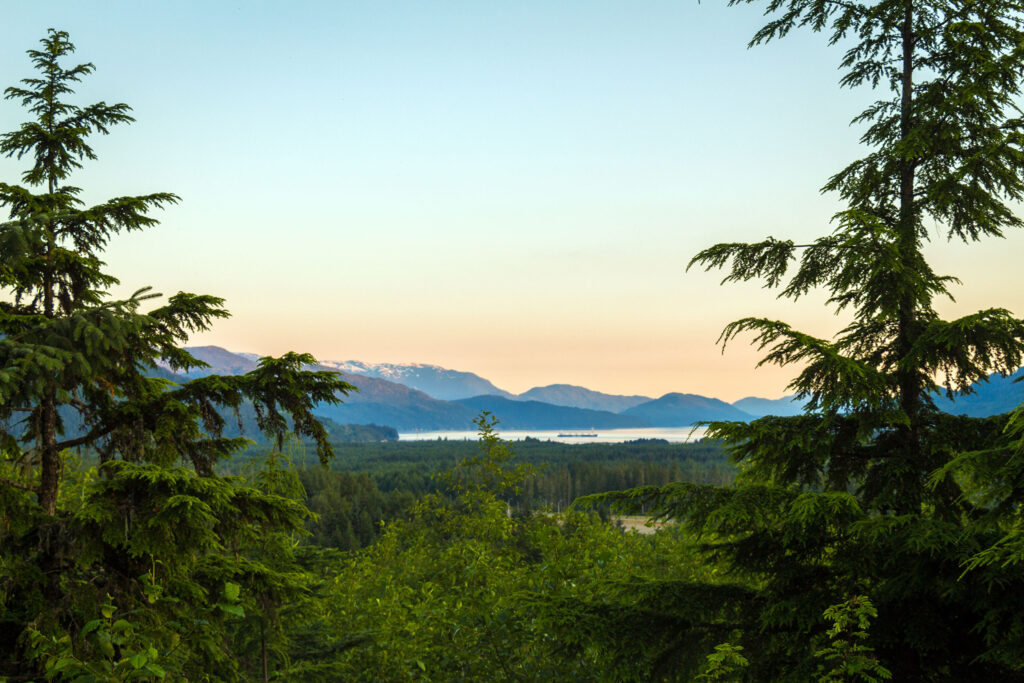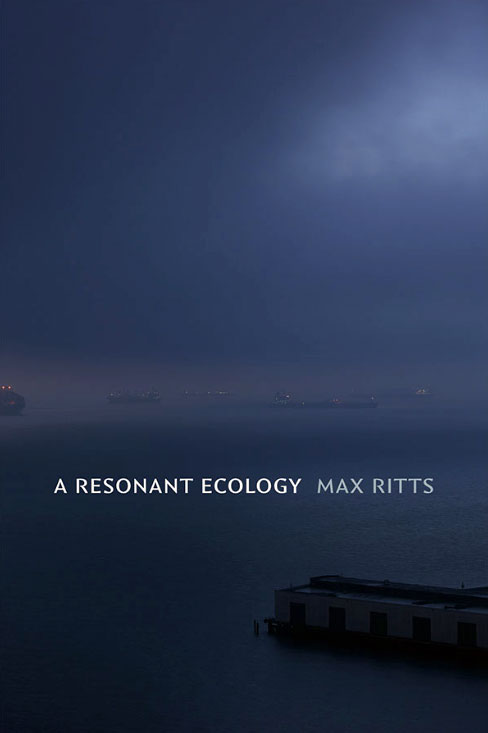
It’s not noise — it’s a symphony
Whale songs. The noise of churning ship propellers. Indigenous black metal. A Roy Orbison tune. To Clark environmental geographer Max Ritts, “sound is an uncertain object, a riddle in a way, that’s potentially positive or potentially negative in its uses.”
It’s a point he drives home in his 2024 book, A Resonant Ecology, which explores the ever-evolving sonic landscape of British Columbia’s North Coast and local Indigenous communities’ response to encroaching development and environmental change.

Ritts’ research for the book began during his Ph.D. program in geography at the University of British Columbia around 2011, as he witnessed protests against oil and gas shipping linked to Alberta’s tar sands, which environmentalists and First Nations feared would impact wildlife and communities around British Columbia’s coast.
“There was this sense that this part of the coast was to be a ‘ground zero’ for an environmental struggle — which it would become — because there was all this opposition to Enbridge, the pipeline company that was proposing to ship tar sands oil,” according to Ritts, assistant professor in the Graduate School of Geography, part of the School of Climate, Environment, and Society.
“There also were liquefied natural gas projects, which were slated to happen in the area. And then there was an Indigenous resurgence, all these Nations saying, ‘If you want to pursue these development projects, they will proceed on our terms, not through the directives of companies in Vancouver or the Bay Area.’ ”
In a recent interview, Ritts delved into themes of his book and described what he learned from conservation scientists on Gil Island studying whale sounds, and from former members of a black metal band in the Gitga’at First Nation — each entrained in different ways to “noise” as a sonic expression of increased industrialization.
What inspired you to research the connections between ecology and sound?
I started my research focus on the tar sands, this mega oil project in Alberta, and I was interested in the terminus of one of the proposed pipelines, which was to go through the North Coast by shipping.
It would stop at a place called Kitimat (in British Columbia), but then the oil would be loaded onto ships that would bisect these very delicate coastal ecologies which are in the Gitga’at .
In 2012, I first visited a whale research station (Cetacea Lab) that was conducting scientific research in anticipation of the impacts of that shipping activity. They had determined that a lot of ships transiting the coastline would affect the whale populations negatively through the production of ocean noise.
I was amazed that they were doing all this listening. It introduced me to the idea that I might study this entire region through sound. Many of the complications I was witnessing — the economic transformations, the expected environmental transformations, but also the ongoing environmental transformations due to climate change, and the Indigenous resurgence responding to these and much deeper transformations — were passing through the medium of sound.
What are the impacts of human-produced sounds on whales?
When ship propellers turn, they create thousands of bubbles that collapse in the water and create this droning sound that really affects humpback whales and killer whales, but also fin whales and, further offshore, grey whales and other animals. All sorts of marine life get impacted.
In species like humpback whales, their own calls get interfered with. It’s called masking. The sound of the ship doesn’t allow them to communicate properly with their conspecifics. In other species, whales have been known to beach themselves in response to other kinds of noise sources like military sonar.
We suspect that there are damages to the whales’ eardrums and hearing abilities over long periods of time. This has been studied with lower-frequency shipping noise, and in other contexts through high-frequency sonar.
The science is still emerging, but there’s loads of work now suggesting an ever-wider range of impacts on species that depend vitally on calling and listening as part of the way they live in the ocean.

Why are you interested in studying the North Coast/Pacific Northwest in particular?
I was interested in the North Coast for its long legacy of resource extraction and the resistance to it. There is industrial whaling — resource extraction — on the one hand, but also various kinds of cultural extractions, such as “salvage ethnography” — a legacy through which early anthropologists visiting the coast at the turn of the last century recorded traditional practices and took objects to “preserve” Indigenous cultures they thought would be lost to “progress.”
So there’s a legacy of extraction via sound, historically, within the Nations, as well as extraction of animal lives and other kinds of resources in terms of whaling and logging and mineral extraction.
The coast has this colonial legacy, which is absolutely essential to the way in which I tried to do my work ethically, and which also figures in how I understood the present phase of development as a layering of political and economic forces.
What type of songs were extracted?
In the book, I refer to one of Marius Barbeau’s essays, “Songs of the Northwest,” written in 1933, where he talks about how the Western musical notation and the Western stave (or staff, with five horizontal, parallel lines where composers write musical notes) can be likened to “a rack on which to pin down sounds.” You’re capturing these sounds and placing them in another context — a western institutional idiom.
That idea of “possessiveness” is one of the throughlines of my book. There’s a certain possessive logic in the way that sounds will be encountered on the coast today, as there was over a century ago. Even the whale sounds — which are ostensibly a means of broadcasting support for the plight of the whales — will become a basis for other kinds of profit-making activities that will continue in that possessive logic, and in ways that can harm the conduct of whale research.
Against this legacy, there’s a lot of work now being done by Indigenous anthropologists and sociologists — including Robin Gray, a Ts’msyen anthropologist in Toronto — called rematriation (an Indigenous feminist reading of “repatriation”). And what they’re referring to are traditional songs about important community activities or harvesting activities, or creation myths that would have been written down or taken by anthropologists such as Claude Lévi Strauss, Franz Boas, and, especially, Marius Barbeau, who produced this huge trove of work about the Northwest Coast.
Can you talk about the music that is present in your book — the Indigenous black metal band and country music, co-existing within the Gitga’at First Nation?
One chapter in the book deals with my relationship with two cousins from the Nation, Spencer Greening and Jeremy Paul. They were in this incredible black metal band, Gyibaaw, for a few years. Their music was joyful and funny and noisy, and it was also very important to the way that they were seeing and interpreting all the economic and environmental changes, and how they were capturing and expressing their identity as Ts’msyen, as Indigenous people, through music.
After they disbanded Gyibaaw in 2012, they started an old-time country music band, The Saltwater Brothers. Their grandfather, Johnny Paul, was a country musician and used to ride the Canadian National Railway singing to people. (Jeremy played at Clark last year under the name “Saltwater Hank.”)
Both country and metal music have this kind of cross-cultural history. They’re not just so-called “white” or “Western” music; they’re also significantly informed by Indigenous people. Robbie Robertson and Hank Williams are two examples. And then there’s all sorts of black metal history as well — Indigenous bands in Brazil and Colombia were really influential to the formation of that genre.
Spencer and Jeremy drawing on these traditions is not an accident; these music genres have always had Indigenous presences in them. In many ways, what we call Western music is significantly informed by communities who don’t get the full appreciation that they deserve.

How are the whale sounds and the Indigenous music connected?
In my book, I consider how both of these sounds — the black metal sounds and the whale sounds — are echoing out from the territory at a time of industrial development, how they are linked to development if not completely “captured” by it. And not only are the sounds echoing out, they’re being interpreted by others in this development context, too. People are listening to them as signs of what may happen or what should happen, they are forming meanings and associations — of an industrial devastation that may be unleashed upon whales, for instance, or a cultural resurgence that may constitute new expressions of Indigenous sovereignty. And so they’re both connected that way.
Interestingly, whale sounds and Indigenous also both connected in terms of noise. The history of the receptions of those musics has involved them being denigrated and disregarded as noise by certain interlocutors.
In the 1950s, naval scientists treated whale sounds as noise, before scientists like Roger Payne recognized them as song. And early explorers of the North Coast regarded Indigenous music as guttural, primitive sound, and noisy, something that continued with early anthropologists who compared it to classical music and didn’t like what they heard. Only much later would they recognize its complexity. Certain kinds of displays were defined as nonsensical or meaningless, as “just an animal sound or a howl.” And it may very well have been a howl, but it also may have, within that howl, also been a story of connection to a territory, or of relatedness to an animal kin.
What do you want people to take away from your book?
I hope the book stands as an affirmation of this incredible part of the world, the North Coast, for all the histories that define it, for all the communities that live there and make it an amazing place. I hope that the book captures something of the uniqueness of the coast — the whales and the nature and histories that exist nowhere else.
The argument of the book is that sound not only provides a unique and enduring way of understanding these transformations for all the communities — and how those communities respond to development projects — but that sound is oftentimes an opaque and uncertain guide. We don’t listen enough; sound can be a more authentic way of being in the world. But it’s also true that sound can be enrolled in all sorts of projects of social control. And we see that especially today with smart technologies and surveillance technologies that use sound to track people and animals and dominate their social relationships through algorithmic means.
Alongside industrial change, the book also follows that throughline — not only do we see industrial development redefine the coast and its politics, but also digitalization. This was not something I expected when I started the research. By 2018, when I finished my fieldwork, it was evident that digitalization was defining how the coast was to be governed for a range of communities with an impact on a range of different kinds of life ways. And these governance changes involved digital music and digital sound.
What does the future hold for the North Coast?
The global demand for energy already has opened the region to new shipping projects and new kinds of oil and gas projects, making a mockery of government claims to sustainable development or the precautionary principle, for which scientists would advocate because this is an extremely delicate ecology. We don’t know what the long-term impacts of ocean noise will be, let alone of warming ocean waters which, for First Nations communities, affected seasonality and literally changed the taste of seaweed.
There is more industrial development on its way, and there are huge risks with those projects, environmental risks and economic disruptions. Alongside, there is more marine governance operating through digital means — smart governance systems that are meant to steer and protect nature as these projects take shape. In one of the book chapters, I discuss the impact of those digitally mediated, smart governance systems that purport to be managing everything sustainably but depend on things that we don’t know will be guaranteed in the future, like endless supplies of data, for example. And they convert vocal sounds into data, and they convert noise into data. And we don’t yet know if those projects will deliver on the things that they say they will, like predictive analytics or real-time regulation, but there are reasons to be suspicious.
What’s next in your research?
I’m looking at the new markets emerging around environmental sensor technologies in mining and oil and gas. Sensors are becoming increasingly important in mineral extraction, in underground mining and also in offshore oil. You have individual projects with literally tens of thousands of sensors trying to make sense of these incredibly hostile, almost inhuman, environments. I’m focusing on Sudbury, Ontario, which has some of the deepest mines in the world. It also has unique geology, a lot of unique mineral wealth because a meteorite landed there, and now all this new proposed activity around smart mining. And these sensors are important for accessing super-deep mining locations and making decisions about what to extract and how. I’m excited about digging into it, no pun intended.


